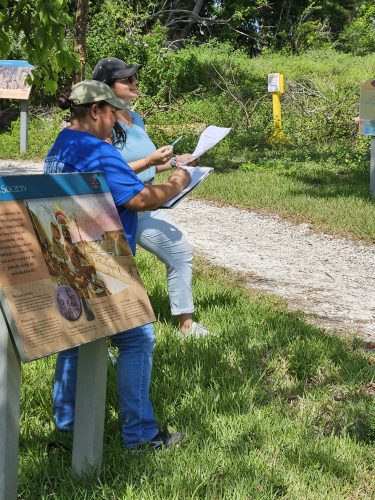One of the coolest things about my job is collaborating with amazing people who share a deep passion for archaeology, heritage preservation, and conservation.

Last August, I had the incredible opportunity to participate in the International Training Course (ITC) on Disaster Risk Management of Cultural Heritage, organized by Ritsumeikan University in collaboration with the International Centre for the Study of the Preservation and Restoration of Cultural Property (ICCROM). I couldn’t resist choosing Pineland Archaeological Site Complex as a case study to prepare a Disaster Risk Management Plan (DRM).
These DRM plans are important because they can better help site managers and staff to prepare and respond to disasters by creating a clear chain of command and steps to take depending on different hazards and disaster scenarios. So, to develop a draft plan for Pineland’s DRM, I had to envision the site’s worst-case scenario. Even before the occurrence of Hurricane Ian, I had already begun envisioning Pineland’s worst-case disaster scenario as a Category 5 hurricane striking southwest Florida, resulting in severe damage to the mounds, artifacts, and other structures. Sadly, this scenario turned into a reality with the landfall of hurricane Ian on September 28, 2022. However, the first-hand experiences and lessons learned from Hurricane Ian have provided valuable insights that I am now grateful to share with others.
Fast forward to early June, Annisa Karim, Operations Manager at the RRC, and I were finally able to sit down at Pineland on a very sunny and humid morning to discuss all of this work. Let’s delve into what we’ve been up to:
Two-fold Education Approach
We recognize the importance of both publicly owned portions and privately owned properties, such as Adam’s Mound of the Pineland Archaeological Site Complex. To address this, we are taking a two-fold educational approach. First, we plan to send letters to private property owners, inviting them to the RRC to discuss potential hazards and risks on their properties. Second, we aim to provide education and information to the staff, volunteers, and the general public associated with emergency preparedness and mitigation measures for natural hazards like flooding, wildfires and hurricanes. To be clear, our information would focus on cultural heritage. We have plenty of very qualified and experienced organizations to help people with personal preparedness.
Incorporating New Information
In our ongoing efforts to develop a comprehensive DRM plan, we are coordinating programs to actively discuss and integrate new insights from the dedicated staff, volunteers, and stakeholders at the RRC. We are particularly excited to incorporate the latest data on archaeological surveys conducted after Hurricane Ian on Pineland by the Florida Museum, Pennsylvania State University, and the University of Georgia. We also discussed starting a process of networking and negotiating with civil protection groups and the Matlacha Fire Department to host training on how they can care for cultural heritage and aid the RRC in better preparing for wildfires.
Putting Plans Into Action
Our objective is to reduce disaster risks to the Pineland Archaeological Site Complex, its captivating landscape, and biodiversity. To achieve this, we are planning to schedule designated days throughout the year to review and practice the preparedness and mitigation measures outlined in the plan. This approach ensures effective mitigation strategies for each zone and heritage attribute of the site, including the archaeological sites, landscape, and buildings.
Join Us!
Recovery from a disaster is a process, not a plan. Places like the Calusa Heritage Trail at the RRC can help us reclaim a sense of normalcy and reestablish our bond with nature. We warmly invite you to stay in the loop and actively engage in the RRC and the Florida Public Archaeology Network’s programs and efforts and we hope to see you soon.
This article was taken from the Friends of the Randell Research Center Newsletter Vol 22, No. 1 & 2. November 2023.